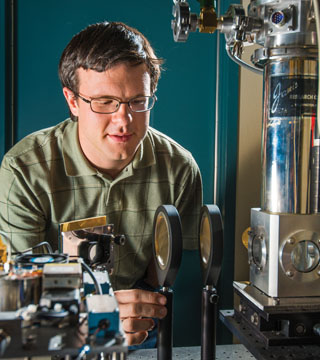
Crystals are noted for the beauty of the light that passes through them. But the atomic arrangements of gems permanently fix the frequencies that are permitted passage.
Now a Sandia-led team has created a plasmonic, or plasma-containing, crystal that is tunable by adjusting the voltage applied to it. Because the crystal is agile in transmitting terahertz light at varying frequencies, it potentially could increase the bandwidth of high-speed communication networks.
“Our experiment is more than a curiosity precisely because our plasma resonances are widely tunable,” says Greg Dyer (1118), co-primary investigator of the paper published online Sept. 29 by Nature Photonics and expected in print in November. “Usually, electromagnetically induced transparencies in more widely known systems like photonic crystals and metamaterials require tuning a laser’s frequencies to match a physical system. Here, we tune our system to match the radiation source. It’s inverting the problem, in a sense.”
Photonic crystals are artificially constructed crystals built to allow transmission of particular wavelengths. Metamaterials require micron- or nano-sized bumps to tailor interactions between manmade structures and light. The plasmonic crystal, with its ability to direct light like a photonic crystal, along with its sub-wavelength, metamaterial-like size, in effect hybridizes the two concepts. Its methods could be used to shrink the size of photonic crystals and to develop tunable metamaterials.
The crystal’s electronic plasma forms naturally at the interface of semiconductors with different band gaps. It sloshes between their atomically smooth boundaries that, properly aligned, form a crystal. Patterned metal electrodes allow its properties to be reconfigured, altering its light transmission range. In addition, defects intentionally mixed into the electron fluid allow light to be transmitted where the crystal is normally opaque.
However, this crystal won’t be sold to beauty lovers any time soon. First, its transmitted light is in the terahertz range, unobservable by human vision. And its output frequencies are electronically varied by precisely tweaking a two-dimensional electron gas, a capability not required by most casual crystal buyers.
The paper is titled “Induced transparency by coupling of Tamm and defect states in tunable terahertz plasmonic crystals.”
Other paper authors are Sandians co-p.i. Eric Shaner, Albert D. Grine, Don Bethke (all 1118), and John L. Reno (1131); Gregory R. Aizin of the City University of New York, and S. James Allen of the Institute for Terahertz Science and Technology, UC Santa Barbara.
The work was supported by the DOE Office of Basic Energy Sciences and performed in part at the Center for Integrated Nanotechnologies, a user facility of DOE BES.